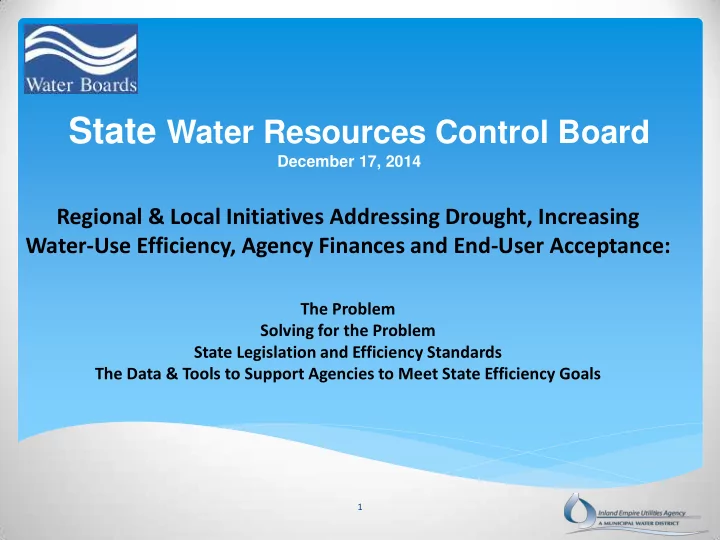

State Water Resources Control Board December 17, 2014 Regional & Local Initiatives Addressing Drought, Increasing Water-Use Efficiency, Agency Finances and End-User Acceptance: The Problem Solving for the Problem State Legislation and Efficiency Standards The Data & Tools to Support Agencies to Meet State Efficiency Goals 1
• MWD member wholesale agency • 7 retail member agencies • 850,000 population in service area • $500 million in “local water” development over past 15 years New Initiatives: • Significant increase in WUE • Assist member agencies with revenue and conservation in the form of new rate designs, data collection, tools, and public outreach • Exceed current 20x2020 goal 2
The Problem: The Solution: Public Policy Water Revenue Efficiency Stability User Satisfaction “ The most important rate design Allocation-based Rates criteria are fiscal adequacy (collection of the agency revenue requirement) , efficiency (encouragement of economically efficient consumption and discouragement of waste) , and fairness to all customer classes.” Residential GPCD Scott Ruban, J.D. National Public Policy Institute 3
The State Has Set the Standards: Indoor Allocation Outdoor Allocation (SBX7-7) (AB 1881) Water Budget = (# Residents) (55gpcd) + (ET) (.80) (SF of Landscape) (DF) 4
Why a Water Budget Rate Design is Sustainable? Agency: End-User: • • Recover costs of service accurately Sends a consistent economic & while customers use less water efficiency message every billing cycle • • Accurately portrays what the Is based on each users specific agency really does (provides situation (equity provided by State “reliable” water service) legislation) • • Recognizes and rewards efficient Changes as weather and other user- users, penalizes water waste circumstances change • • Provides the retail agency with a Places the responsibility of water new, independent source of efficiency directly at the end-user Source: UCR study of EMWD funding for conservation programs level, but deploys State standards WBBR structure (paid only by those who use water in accordance with a range of over State efficiency standards) legislative actions 5
Regional & Local Agency Initiative Collect Data (ET) (.80) (SF of Landscape) Prop 8 Prop 84 4 Gr Grant ant Western Municipal WD Eastern Municipal WD San Bernardino Valley WD Orange Co. Water District Inland Empire Utilities Agency 6
Use Data to Measure Efficiency Build Tools Water Efficiency Calculator - SFR Cust. Average Usage as Percentage of No Water Budget 42527-1 260.1% Enter input data in the orange cells. Most inefficient 41617-1 259.4% Customer No. 40597-2 users, top drought Zone 1280 40726-1 256.0% response targets Meter Size 5/8-in 42525-1 252.9% Indoor Consumption Number of Residents 2.8 Persons Cust. Average Usage as Percentage of Daily Indoor per Person Allocation 55 Gallons No Water Budget Efficient customers 40688-1 35.3% Outdoor Consumption 40035-1 34.0% not included in Landscape Factor Turf Coefficients 40107-1 33.0% drought outreach January 0.61 40935-1 31.5% February 0.64 March 0.75 April 1.04 Consumption % of Customers May 0.95 June 0.88 July 0.94 At or below allocation 74.1% August 0.86 September 0.74 Greater than 100% up to 125% of allocation 17.6% October 0.75 November 0.69 Greater than 125% up to 150% of allocation 5.1% December 0.6 Landscape Area (Square Feet) 13098 More than 150% of allocation 3.2% 7 Drought Factor 20 % REFRESH AFTER UPDATING ALL INPUTS
How Would Data be Used? • To build a “Water Efficiency Calculator” to rank and sort accounts by efficiency • To direct conservation funds for the most cost-effective use • To build a “water budget rate modeling tool” • To populate retail agency billing systems to support Indoor Outdoor Inefficient Excessive Unsustainable water budget based rate structures 8
The Cost of Not Changing? Economic, Environmental & Political The Law of Diffusion (Why “Change” is Hard) $1/day/household $.002 / gal 9
Recommendations: Be clear about State efficiency • Expand Board support for allocation- standards; Help us build the based rates building on the tools that incentivize market- “Alternative compliance” mechanism based, fiscally responsible water as described in the July Emergency rate structures that incorporate Regulations .” State efficiency standards. GPCD comparisons have • Require agencies to report the % of limitations; reporting % of users who meet State water accounts meeting efficiency efficiency standards. standards is equitable across agencies and helps to target water waste. • Conduct State-wide training on the Consider how to make the technologies necessary to measure technology and/or data available water-use efficiency. to agencies across the State. 10
Questions? 6075 Kimball Avenue Chino, CA 91708 (909) 993-1600 www.ieua.org
Recommend
More recommend